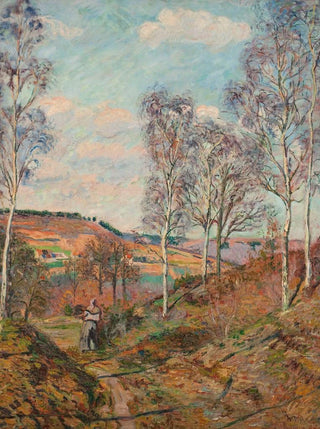Art print | The Path to the Valley - Armand Guillaumin


View from behind

Frame (optional)
In the vast panorama of Impressionism, "The Path to the Valley" by Armand Guillaumin stands out for its brightness and its atmosphere filled with serenity. This artwork, which evokes a walk in nature, invites the viewer to immerse themselves in a landscape where the sky and the earth meet in a colorful harmony. Guillaumin, often less known than his contemporaries, manages to capture the very essence of light, transforming each brushstroke into an ode to the beauty of the natural world. The art print of this piece allows for rediscovering the magic of this suspended moment, where time seems to stretch with the nuances.
Style and uniqueness of the artwork
Guillaumin's style is characterized by bold use of colors and a brush technique that brings his landscapes to life. In "The Path to the Valley," the artist plays with contrasts between the vibrant greens of the trees and the deep blue skies, creating a lively and dynamic atmosphere. The brushstrokes, both light and energetic, seem to dance across the canvas, evoking the movement of the breeze through the foliage. This work stands out for its almost tactile approach to nature, where each element is rendered with such precision that one can almost feel the freshness of the air. The composition, in turn, guides the viewer's gaze along a winding path, inviting a visual exploration that evokes a contemplative walk.
The artist and his influence
Armand Guillaumin, born in 1841, is an artist whose career is intimately linked to the evolution of Impressionism. Although he did not benefit from the same notoriety as figures like Monet or Renoir, his work has been an inspiration for many artists. Guillaumin developed a style that is uniquely his own, blending sensitivity to light with a love for rural landscapes. His participation in Impressionist exhibitions and his friendships with other great masters of his time testify to his role in this artistic movement. By rediscovering "The Path to the Valley," one better understands how Guillaumin contributed to shaping

Matte finish

View from behind

Frame (optional)
In the vast panorama of Impressionism, "The Path to the Valley" by Armand Guillaumin stands out for its brightness and its atmosphere filled with serenity. This artwork, which evokes a walk in nature, invites the viewer to immerse themselves in a landscape where the sky and the earth meet in a colorful harmony. Guillaumin, often less known than his contemporaries, manages to capture the very essence of light, transforming each brushstroke into an ode to the beauty of the natural world. The art print of this piece allows for rediscovering the magic of this suspended moment, where time seems to stretch with the nuances.
Style and uniqueness of the artwork
Guillaumin's style is characterized by bold use of colors and a brush technique that brings his landscapes to life. In "The Path to the Valley," the artist plays with contrasts between the vibrant greens of the trees and the deep blue skies, creating a lively and dynamic atmosphere. The brushstrokes, both light and energetic, seem to dance across the canvas, evoking the movement of the breeze through the foliage. This work stands out for its almost tactile approach to nature, where each element is rendered with such precision that one can almost feel the freshness of the air. The composition, in turn, guides the viewer's gaze along a winding path, inviting a visual exploration that evokes a contemplative walk.
The artist and his influence
Armand Guillaumin, born in 1841, is an artist whose career is intimately linked to the evolution of Impressionism. Although he did not benefit from the same notoriety as figures like Monet or Renoir, his work has been an inspiration for many artists. Guillaumin developed a style that is uniquely his own, blending sensitivity to light with a love for rural landscapes. His participation in Impressionist exhibitions and his friendships with other great masters of his time testify to his role in this artistic movement. By rediscovering "The Path to the Valley," one better understands how Guillaumin contributed to shaping






